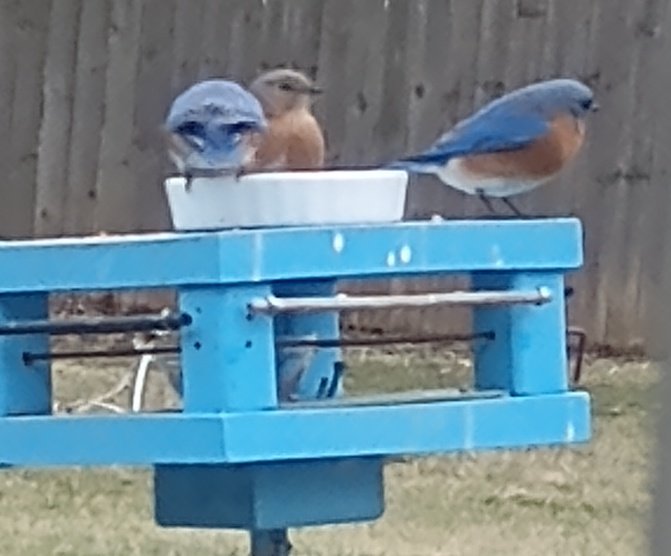Say hello to a few of my backyard pets. Yes, our neighborhood is home to many of them. At one point, the native eastern bluebird was near extinction due to stiff competition from the english house sparrow. They both are cavity nesters, and house sparrows have been known to remove bluebird eggs and throw them on the ground, or kill the fledglings and sometimes the parents too. Bluebirds are making a rebound due to help from backyard birders providing them with food, shelter, water, and protection from predators. If you would like to be a part of this effort, here’s a few easy tips I’ve learned from raising them over the 6 years. Every winter I will have 6 or 8 that winter over.
Housing
Purchase or make houses designed for bluebirds. They have a deeper cavity and the opening is 1 & 1/2″ wide to keep out the bully birds, cats, and squirrels. Mount them on a metal pole away from fences or trees about 5′ – 6′ high (you can use a metal hose clamp. Just fasten 2 on the back of the house and tighten them around the pole). Turn the opening toward the S.E. Discourage sparrows and other small birds from nesting in them by pulling out the nests and throwing them away. Bluebirds love to use pine needles for their nests, and make a beautiful tightly woven nest. Usually they start nest making in March. Clean out the house after the fledglings have left, and more will nest in them. They also love to nest in our old trees especially in an old Woodpecker opening.
Food
Bluebirds, along with every other bird, love dried mealworms. They prefer being fed in a small low bowl, but it’s very hard to keep the starlings, and robins away from the worms. They eat more frequently in the early morning hours around dawn, and just before dusk. You can purchase 5lb. bags of dried mealworms at Rural King, or from Chewy.com ($30/5lb). While mealworms are high in protein and some other goodies, they do not provide calcium needed for strong eggshells. Mix in some calcium carbonate (Amazon has it) for a good calcium source. There are several specific feeders for bluebird mealworms that help protect them and the mealworms or you can make your own. Check on line.
Water
Keep fresh water for them especially during our dry summers.
Fledglings
Keep an eye out for the bluebird fledglings. They don’t look a thing like the parents. In fact are quite homely. The parent birds usually bring them to the feeder, and show them how to eat the mealworms. They will often have 1 – 5 fledglings in a brood, and 1 – 2 broods per season.
Bluebirds make a wonderful back yard pet. If only there was a diaper for them?

